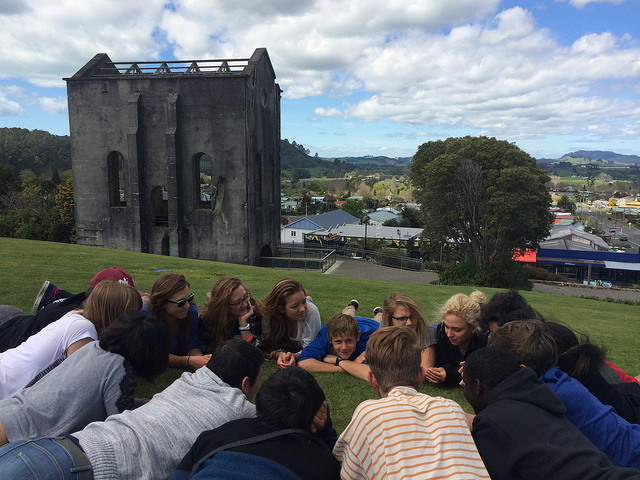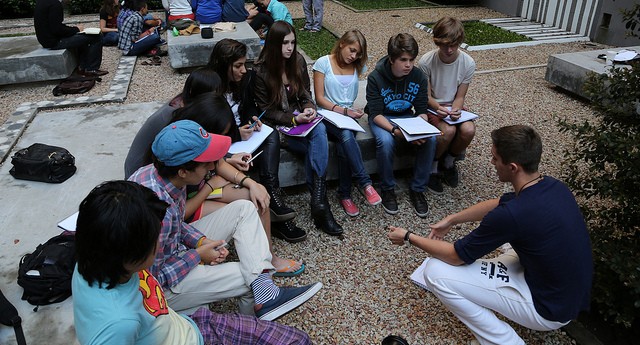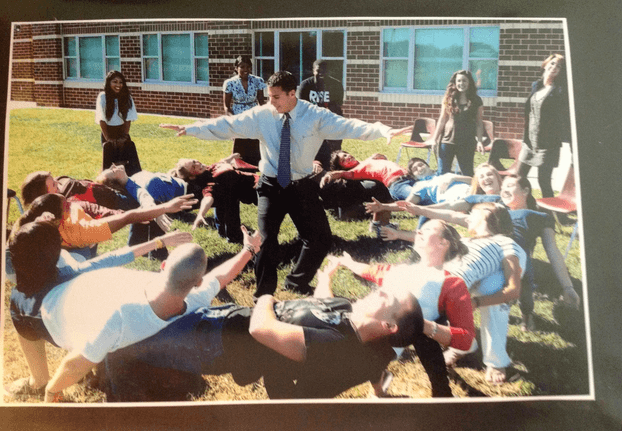1) Hi Nada, can you tell us what you've been up to since graduating from THINK Global School in 2022? Since graduating in 2022, I've been pursuing a passion I found while at TGS, sustainability, and I am currently majoring in engineering in renewable energy systems at Al Akhawayn University, in Ifrane, Morocco. But there is way more than that! I've had a chance also to explore the world of...
Read More
Students from all grades collaborate on a project in Auckland, New Zealand
As the first term of our 2014-15 school year recently wound to a close in New Zealand, I looked through the student survey responses for my course and remembered one of my opening statements to the ninth and tenth grade students:
“We run an educational model that is complicated but impressively different than most schools around the world. In order to set the foundation for optimal learning at our unique school, the aim in the ninth and tenth grade is to collaborate, not compete.”
The students who attend THINK Global School come to us from an ever-expanding list of countries, and the quality of education they’ve received at prior institutions can vary extensively. Due to our rigorous application process, we get high-quality students who, in some way shape or form, stood out at their old school. Most of these students were outliers in their old institutions because of their skills in communication, writing, mathematics, or critical thinking — a skill that our application process carefully identifies. They enter THINK Global School with a certain set of competencies, and they are used to applying these skills in a competitive way with their classmates, to be recognized in their schools back home.

Liam collaborates with his younger classmates on a project
At the start of each school year, I clarify with my students that classes under my instruction will not be competitive. Not surprisingly, this results in a sea of shocked looks from those taught at their previous institutions to try and best their classmates on every project and assignment. It’s often ingrained in them that school is a chance to do their best and showcase why they are better than their peers.
This statement is followed by confused glances, uneasy smiles, and an unknown feeling of complete educational culture shock. I explain that, collectively, our classes will make incredible projects that will challenge us and demonstrate our strong skills and conceptual understandings to the world.
Each of our students comes with a unique world view and skill set, so it would be a crime for me to disregard their diversity and push an individualized educational model on the room. The class instead becomes a working model for teamwork.
Don’t teach me what to think, teach me how to think
Randy Pausch, the author of a powerful book on teaching and life, The Last Lecture, uses the metaphor of a poker game to illustrate solid teamwork skills. He suggests within his metaphor that strong teams would lay all of their cards on the table and see what they could collectively make of the hand. This is the model that I try to follow with my ninth and tenth grade students. The most powerful thing about this model is that I, the teacher, am another contributing member to class projects rather than the gatekeeper of knowledge. I ask:
- What can we collectively make of this information?
- How can we share our skills to create something unique?
- How can you apply your skills to someone else’s project?
At THINK Global School one of our mottos is “Don’t teach me what to think, teach me how to think.” This model allows students to utilize their abilities, collaborate on new skill development, and work collaboratively to create unique and meaningful pieces of work. The format of most unit projects involves me front-loading critical place-based content from our host countries in either a flipped or traditional way. After key place-based themes are understood and discussed in class, I lay out a challenge — usually in the form of a hashtag.
Some of our successful hashtag projects:
#doersandfighters
#feudaljapan
#tikangaorals
#sitreplandrights
The surveys that students fill out for me at the end of each term highlight the successes of this model. I simply ask students to reflect on whether or not they put 100% of their effort into each project and what they learned through each “hashtag project” by highlighting their glows and grows. Their responses emphatically illustrate the breadth of the learning outcomes from a single semester. Each student learns myriad project-relevant skills for each piece they create, and their responses range from essay structure, stop-motion video animation, and powerful oral presentation skills to the effective use of timelines in writing narrative histories. Their learning outcomes are substantially more than a teacher can plan for, and their final projects are more impressive than any project that a teacher can assign.

Students from Nick’s former school form a human bridge as a team
One ninth grader explained that he learned the following during our first semester in New Zealand:
- How to give a good presentation — 5 P’s
- How to look at the world in a less judging way, like: You’re wrong, that’s not how I do it
- Essay writing growth
- Citations/quotations
- Combining facts and research
- Combining essay/blogs
- Photography
- Maori culture
- Culture appreciation
After each semester, the learning outcomes multiply as students collaborate on new projects. The students that learned stop-motion can assist another group of students who were inspired to use that medium. Those that discovered a new online research method can share the websites they used or the strategies that worked for them. The model not only opens the door for effective student-led collaboration, but it also provides student investment in projects that are not their own. One of the most powerful examples I’ve come across at THINK Global School is the inter-grade level collaboration on projects and the involvement of all students in each other’s learning. From photography skills to essay writing, the entire student body adheres to this model of collaboration, not competition.
World Wide Walkers
Many great examples of our students’ successes can be seen on their class-run and -curated blog, World Wide Walkers. Below are some links to some excellent examples of student achievement:
- Click here to view Yodsel’s skills demonstrating the aqueduct systems in ancient Harappan society in India using Google Sketch-up, a 3d architectural software program.
- Click here for an infographic created by River using Adobe Photoshop regarding similarities in culture practice in Russia and Japan.
- Click here to watch Sydney’s animated short about the spread of religions using PowToon.
Not only does this concept apply to students, but in my next blog post on this topic I outline the factors that created my professional transition to this philosophy as well.
Thanks for reading,
-Nick